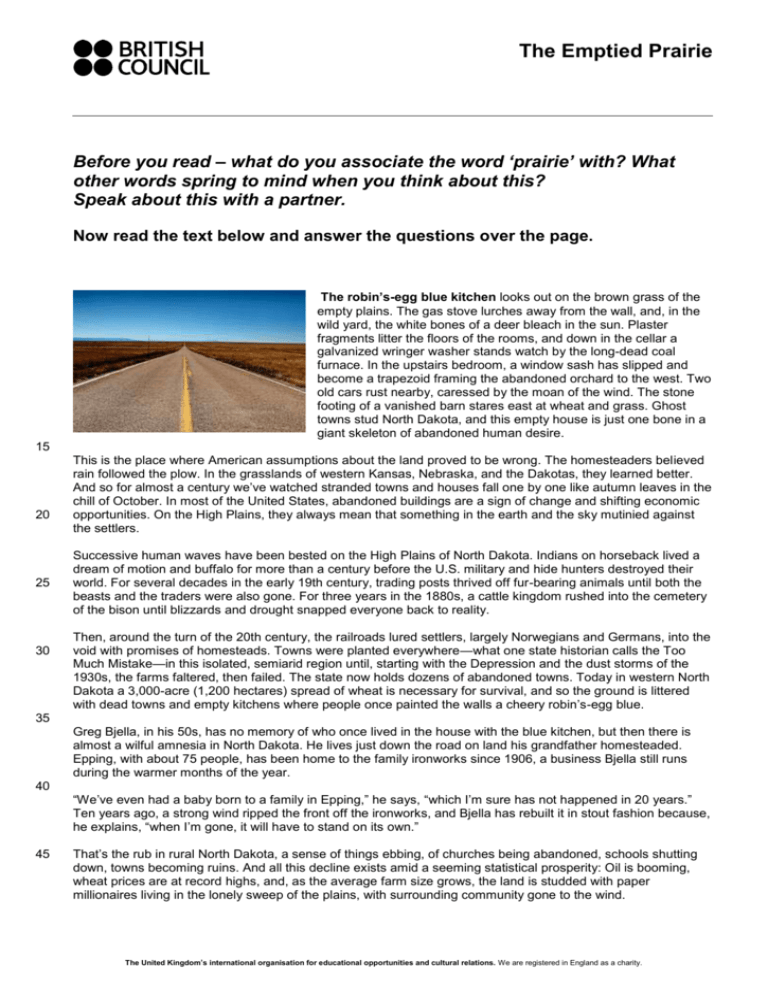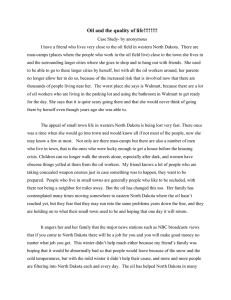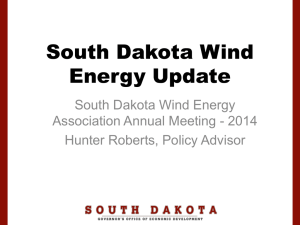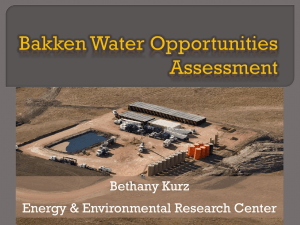The Emptied Prairie
advertisement

The Emptied Prairie Before you read – what do you associate the word ‘prairie’ with? What other words spring to mind when you think about this? Speak about this with a partner. Now read the text below and answer the questions over the page. 5 10 The robin’s-egg blue kitchen looks out on the brown grass of the empty plains. The gas stove lurches away from the wall, and, in the wild yard, the white bones of a deer bleach in the sun. Plaster fragments litter the floors of the rooms, and down in the cellar a galvanized wringer washer stands watch by the long-dead coal furnace. In the upstairs bedroom, a window sash has slipped and become a trapezoid framing the abandoned orchard to the west. Two old cars rust nearby, caressed by the moan of the wind. The stone footing of a vanished barn stares east at wheat and grass. Ghost towns stud North Dakota, and this empty house is just one bone in a giant skeleton of abandoned human desire. 15 20 25 30 This is the place where American assumptions about the land proved to be wrong. The homesteaders believed rain followed the plow. In the grasslands of western Kansas, Nebraska, and the Dakotas, they learned better. And so for almost a century we’ve watched stranded towns and houses fall one by one like autumn leaves in the chill of October. In most of the United States, abandoned buildings are a sign of change and shifting economic opportunities. On the High Plains, they always mean that something in the earth and the sky mutinied against the settlers. Successive human waves have been bested on the High Plains of North Dakota. Indians on horseback lived a dream of motion and buffalo for more than a century before the U.S. military and hide hunters destroyed their world. For several decades in the early 19th century, trading posts thrived off fur-bearing animals until both the beasts and the traders were also gone. For three years in the 1880s, a cattle kingdom rushed into the cemetery of the bison until blizzards and drought snapped everyone back to reality. Then, around the turn of the 20th century, the railroads lured settlers, largely Norwegians and Germans, into the void with promises of homesteads. Towns were planted everywhere—what one state historian calls the Too Much Mistake—in this isolated, semiarid region until, starting with the Depression and the dust storms of the 1930s, the farms faltered, then failed. The state now holds dozens of abandoned towns. Today in western North Dakota a 3,000-acre (1,200 hectares) spread of wheat is necessary for survival, and so the ground is littered with dead towns and empty kitchens where people once painted the walls a cheery robin’s-egg blue. 35 Greg Bjella, in his 50s, has no memory of who once lived in the house with the blue kitchen, but then there is almost a wilful amnesia in North Dakota. He lives just down the road on land his grandfather homesteaded. Epping, with about 75 people, has been home to the family ironworks since 1906, a business Bjella still runs during the warmer months of the year. 40 “We’ve even had a baby born to a family in Epping,” he says, “which I’m sure has not happened in 20 years.” Ten years ago, a strong wind ripped the front off the ironworks, and Bjella has rebuilt it in stout fashion because, he explains, “when I’m gone, it will have to stand on its own.” 45 That’s the rub in rural North Dakota, a sense of things ebbing, of churches being abandoned, schools shutting down, towns becoming ruins. And all this decline exists amid a seeming statistical prosperity: Oil is booming, wheat prices are at record highs, and, as the average farm size grows, the land is studded with paper millionaires living in the lonely sweep of the plains, with surrounding community gone to the wind. The United Kingdom’s international organisation for educational opportunities and cultural relations. We are registered in England as a charity. 50 North Dakota is among the windiest states in the Union and one of the coldest south of Alaska. Twice the legislature has considered changing the name to simply Dakota to shake the chill from its image. The state’s population has stabilized at around 600,000 thanks mainly to the growth around its cities—Fargo, Grand Forks, Mandan, and Bismarck. But out on the land, the population has relentlessly bled away. So there is money and prosperity and the numbing sense that comes from living in a vanishing world. Where do you think this text might have been taken from? Does the author have an emotional stake in the subject matter? Can you think of a word to describe the overall feel of this piece of writing? A. Now answer the following questions individually. 1. Which of these best describes the state of the house mentioned in the first paragraph? a. b. c. d. Some of the rooms are in better shape than others. It is just about liveable. It appears to be abandoned. It is full of rubbish. 2. People were drawn to the grasslands because, a. b. c. d. It appeared to be an exciting place to live They thought the weather would be better than it was They thought it would be easy to work the land They gave in to their emotions 3. Of all the attempts to settle in the prairie, a. b. c. d. None of them were sustainable in this natural environment. All of them could have succeeded but for the weather. One was not thwarted by natural limitations. The most successful had the railways to thank. 4. Which of these statements most accurately describes the attitude of Greg Bjella? a. b. c. d. He has a fatalistic view of life in his hometown. He is optimistic for the future of Epping. In his view the town is as good as finished. He doesn’t like to talk about what has happened there. 5. What does the text tell us about the economic and social outlook throughout the region of North Dakota? a. b. c. d. The region is facing economic ruin. The countryside is causing financial hardship for all who live there. There is a statistical decline in the number of inhabitants. The largest centres of population are better off than most. Page 2 of 3 B. Find the words or phrases in the text that match these definitions (they are in given in the order that they appear in the text). Definition Word / phrase 1 tips or rolls to one side, as of a ship or a staggering person (vb) 2 touched, stroked, etc., lightly, as if in affection (vb) 3 prolonged, low, inarticulate sound uttered from or as if from physical or mental suffering (n) 4 left in a difficult or helpless position (adj) 5 the pelt or skin of one of the larger animals (cow, horse, buffalo, etc.), raw or dressed.(n) 6 grew or developed vigorously; flourished (vb) 7 attracted, enticed, or tempted (vb) 8 operated or performed unsteadily or with a loss of effectiveness (vb) 9 deliberate, voluntary, or intentional (adj) 10 strong and thick or heavy (adj) 11 dotted or adorned with (adj) 12 a continuous extent or stretch (n) (text source – National Geographic magazine How would you feel about living in such a place? Could there be any advantages? Are there areas of your country that are similar to this? Steve Evans 01/08 Page 3 of 3






